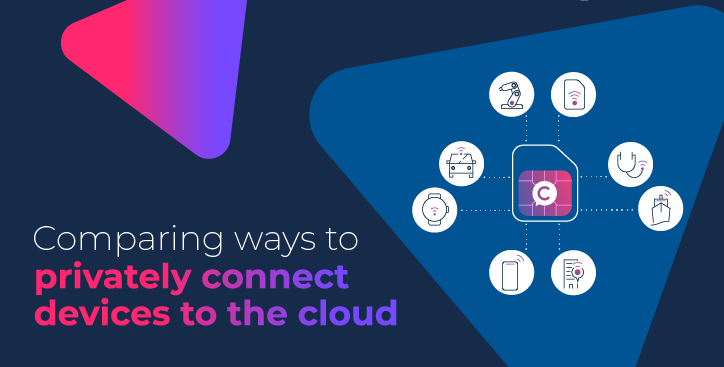Comparing ways to privately connect devices to the cloud
By Alex Hawkes|16 April, 2024

The biggest driver behind the Internet of Things (IoT) is the value that can be unlocked through data analytics. When you have hundreds, thousands, or millions of devices capable of reporting on an almost unlimited number of attributes, statuses, or environmental factors, the opportunity for businesses to create optimisations or brand new revenue streams is huge.
The cloud plays a pivotal role in this potential as the brain where all the data processing happens, yet the benefits can only truly be realised if the information generated by the IoT devices is able to get to the right place - the compute point - at the right time.
If enterprises can get the above factors right, they can reap the benefits. IoT generates massive amounts of data, and advancements in cloud data analytics, and increasingly AI, are making it possible to extract valuable insights that can be used to make informed decisions, optimise processes, and ultimately impact the bottom line.
All of the major cloud platforms, from AWS, Azure, and Google Cloud, through to IBM, Cisco, and Oracle, have introduced IoT-specific capabilities and almost all sectors, including agriculture, healthcare, manufacturing, and logistics, have developed tailored IoT solutions to solve unique challenges.
When it comes to connecting IoT devices to the cloud, some of the most common options are:
- Private LTE/5G networks: With the advent of 5G, fully private cellular networks are now a possibility. Usually limited to geographically large or complex campus deployment, a private 5G network can demonstrate a Return on Investment (ROI) for things like mining operations or a remote manufacturing. Increasingly these types of operations need to connect equipment or machines, such as large mining vehicles, to the cloud in order for applications such as predictive maintenance, software improvements and AI feeds.
- IoT connectivity management platforms: Some wireless connectivity providers are able to connect IoT devices directly to the cloud. However, they lack depth in their range of cloud connectivity and are often limited by region or cloud provider. Redundancy can also be an issue. This can present long term challenges to enterprises particularly when they are dealing with complex multi-cloud management. Furthermore, as security is provided by VPN, this can introduce overheads when it comes to software management and lifecycles.
Other IoT connectivity management platforms focus on the low-cost end of the market and backhaul data to the cloud over the public internet. For example:
- Local MNO (Mobile Network Operator): Many local Mobile Network Operators offer a low cost IoT capable SIM, but the challenge here is with international mobility and roaming, and whether roaming agreements with other operators are in place and whether they are adequate. In some cases, a localised eSIM or multi-IMSI profile, that activates when the device changes location, would be preferable if the IoT devices are roaming long-term.
Securely connect IoT devices to the cloud with Edge SIM
Public internet backhauling is a common challenge for most IoT connectivity solutions. Once data leaves the cellular network via the mobile gateway, it touches the internet to get to the cloud application server, and this does not provide the required security or reliability for enterprise IoT deployments, especially those in sensitive sectors like finance and healthcare.
When looking at any IoT device using internet backhaul, either provided by an MNO or an IoT connectivity management platform, you must consider:
- Security: Internet backhaul is insecure and vulnerable to attack, potentially exposing sensitive data.
- Reliability: The public internet is a best effort network and this can lead to service disruption, downtime and loss of business.
- Performance: Public internet bandwidth and network speed is not guaranteed and internet routing is optimised for cost, resulting in inefficient traffic routes.
To avoid the security threats of internet backhauling, your business might want to consider a solution like Edge SIM from Console Connect. We offer a next-generation connectivity management platform that natively and securely connects an IoT device to the cloud without touching the public internet.
The considerations for an Edge SIM using private connectivity are different:
- Security: All your IoT traffic bypasses the public internet, which significantly reduces the threat of a cyberattack.
- Reliability: Edge SIM is not a VPN. No software is required on the device or on the
cloud. Edge SIM directly traffic passes from a mobile gateway directly to a global Layer 3 network, and the Console Connect network offers a guaranteed level of service with 99.99% service availability. - Performance: The Console Connect network is optimised for performance and ensures your traffic is delivered via the most efficient routes with stringent SLAs, covering jitter, packet loss and latency.
This makes Edge SIM by Console Connect particularly well-suited to IoT applications with sensitive or mission critical data, including:
- Asset management
- Network management
- Logistics
- Connected cars
- Payment networks and POS devices
- Live broadcast
- Healthcare solutions
- Security systems


.jpg)





.jpg)
